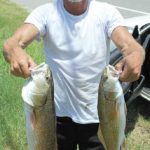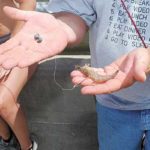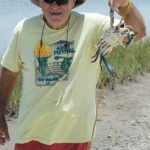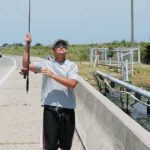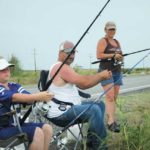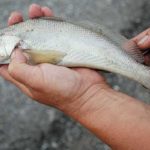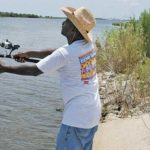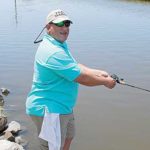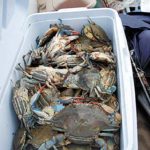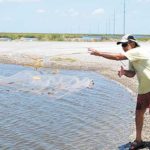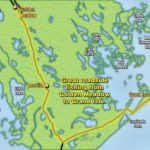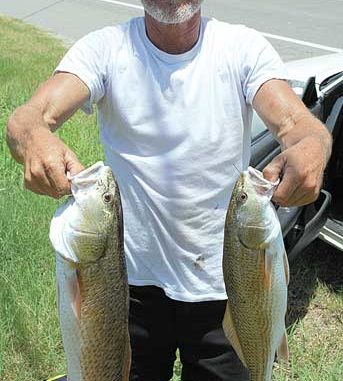
Think all those poor saps fishing along Highway 1 are striking out? Think again.
Over four decades of rolling down Louisiana Highway 1 to Grand Isle, I’ve whizzed by hundreds of them — those stalwart souls fishing off the shoulder of the road or its bridges. “Poor folks,” I would think, “this must be their first trip down here and they just don’t know where to go to catch fish.”
Finally, my curiosity got the better of me. I pulled off the road, got out of my truck and sashayed up to a trio of them.
“You catching anything?” I asked, directing my question to the rugged Papa Bear of the group.
Firmly planted in his folding chair like it was a throne, Tonto Bradley turned a baleful eye on me, but never said a word. Looking for help, I turned to his attractive companion, Denise Hill. She smiled faintly, but said nothing.
I was beginning to look for a way to retreat when Gabriel Steinwinder, Hill’s 11-year old son rescued me.
“We’re catching all kinds of fish, and we got an ice chest of crabs in back of the truck too,” he volunteered. “Last trip I caught a 31-inch redfish. This place has lots of redfish and black drum.”
With the conversation now in my comfort zone, I asked where they were from and what their occupations were. Hill allowed that Bradley was a mechanic and she was a boilermaker and that they were residents of LaPlace.
I reactively responded that I thought boiler makers were supposed to be tough guys. With a level gaze that didn’t allow for dispute, she said, “I am tough.”
“Oops,” I thought, “I fumbled the ball again.”
But young Gabe, who obviously has a career waiting for him as someone’s press secretary, bailed me out once more.
“Ya want some tips?” he asked.
When I replied in the affirmative, he rattled them off: “Bring plenty of sunblock. Bring a folding chair. Bring plenty to drink. Bring plenty of tackle because you can lose a lot. Use big enough hooks; lots of people use perch hooks. Bring crab nets to catch crabs while you’re fishing.”
With the ice not just broken but completely melted, Hill escorted me to their pickup truck to check out the ice chests of big female crabs that they caught in an hour and a half earlier that morning. She explained their fishing strategy as well.
Their preferred places to fish, she said, are where small bayous or drains empty from the marsh into roadside waters. Best catches are made near high tide, when fish move into the shallows. Preferred times are 5 a.m. to 8 a.m., although they fish other times as well.
As we chatted, I watched Bradley and Steinwinder reel in fish after fish — redfish, black drum, pan-sized croakers and gulf kingfish, a.k.a. channel mullet. Their rigs were simple, a bell sinker on the end of their line and a stout hook baited with market shrimp on a 12-inch dropper above the sinker.
It became obvious that I was watching pros in action, and was confirmed when Hill told me that she and Bradley have fished Highway 1 for 32 years.
Oblivious to the vehicles zooming by, she said, “This is a lot better and safer than Elmer’s Island was. I watched too many people drown there.”
During a pause in the action, Bradley rested his rod on his lap, and finally spoke. With a surprisingly gentle voice, he looked out over the marsh, sighed, and said, “It’s great down here. I just love the breeze from the coast.”
Intrigued, I hopped back in my truck and stopped near the next car on the shoulder. The huge umbrella sticking out of the rear window of his car marked the man, busy throwing a cast net for bait, as a Highway 1 pro. He was George Kourkoutis, a 74-year-old Greek expatriate, a retired stock broker and presently a part-time currency trader from Kenner. Kourkoutis, who is in his 40th year as a Highway 1 fisherman, had a simple reason for fishing there.
“I like to fish the highway because there are fish here,” he said.
Kourkoutis is a serious redfish specialist, and uses live shrimp, live minnows, cut mullet and dead shrimp to catch them. He regularly catches limits of redfish up to 24 inches along the road, especially near culverts under the road. He picks off some trout and flounder as well.
As Kourkoutis diverged from fishing into discussing his great grandfather, who he says was a buccaneer on the Mediterranean island of Crete, I heard something in the water behind my left shoulder. What appeared to be a menacing loup-garrou was emerging from the fetid marsh waters. If I hadn’t seen the tether, I would have bolted.
Noticing my caution, Kourkoutis said, “Oh, that’s just Nanouk. Don’t pay any attention to him. He’s my wolf.”
Of course.
The next stop was with James Brown of Luling. Another veteran, Brown fishes the highway twice a month year-round, and has done so for over 35 years.
“I like fishing here, and it’s a nice ride down,” he said. “I catch lots of redfish and sheepshead in the winter, and in the summer, trout bite real good.”
He fishes with market bait, cut mullet and cracked crab under a popping cork.
Brown likes to eat fish. Besides redfish, sheepshead and trout, he catches black drum and croakers, and he never throws a hardhead catfish back.
“They’re good to eat,” he says enthusiastically.
Down the road, semi-crouched in the marsh grass to lower his profile, was 50-year-old Buck Adam from Avondale. That day, he was using live cocahoes to target redfish, and was doing well, filling out his limit as I watched him. He commonly catches redfish up to 27 inches in shallow marsh waters ponded up next to the highway.
“I really like redfish. They give a good fight,” he said. “But I catch specks and flounder too, sometimes using plastic baits. And I catch some big, monster crabs. Last trip, I caught four and a half dozen in six nets.”
Adam splits his time between Highway 1 and Port Sulphur, fishing every weekend from June through September.
Like seemingly every other Highway 1 fisherman, he is oblivious to the traffic, the snarling 18-wheelers carrying loads of pipe down the road to Port Fourchon, the thundering packs of motorcycles making their weekend runs to Grand Isle and the suburbanites pulling $60,000 boats behind huge, shiny SUVs and over-sized pick-ups.
“This is relaxing,” he said. “It’s like being in the woods. The cars don’t bother me at all, and they don’t bother the fish.”
And so it went. I also met Manny Miranda Jr., a 47-year-old insurance company representative from Metairie, Sean Harris, 20, Brandon Winston, 19, both technical specialists and both from Denham Springs, Harvey Allen, III, 29, Byron Brunet, 22, and Enrique Bustos, 14, all of Golden Meadow and all relatives. Allen was teaching his sons, Corbin and Harvey, IV, to fish.
Manny Miranda Sr., a 78-year-old Nicaraguan immigrant and long-time U.S. citizen, watched his son and namesake fish intently off rock rip-rap along the highway.
“He fishes here or from the bank in Cocodrie or Dulac every god dang Sunday, no matter if it got a hurricane,” he said.
Manny Jr. retorts that he is a “semi-pro bank angler,” claiming that it is much safer than fishing from a boat.
“When you fish from a boat and get too hot, you are in a world of hurt,” he said.
He likes to fish colored jigheads tipped with shrimp under popping corks. But he cautions not to pop the cork too much because the fish are “really scary” in shallow water.
Miranda catches “some monster redfish” as well as black drum, flounder and croakers, and he says October is the best month to fish Highway 1.
“A lot of people in cars don’t figure there are fish here,” he says, grinning.
Asked about the traffic, the 18-year Highway 1 veteran replies, “Oh no, the cars don’t bother me. I really enjoy the scenery; sometimes it gets so beautiful. Fishing here is relaxing and relieves stress.”
I figured that I had the Highway 1 fishing scene down pat, but on a whim, made one more stop to talk to a party of four fishing from one of the three small bridges between Chenier Caminada and the Fourchon Road turnoff.
I walked past the two kids to the two adult men, brothers Tom and Charles Matz of Baton Rouge, and introduced myself. After a little chit-chat, I asked, “What are the kids’ names?”
I heard an exasperated gasp behind me from one of the “kids,” and Charles Matz, dropped to his knees convulsing in laughter. I had obviously kept my record of faux pas intact.
Wiping the tears from his eyes, he introduced the girl kid as Samantha, the mother of their three children. She smiled at me sweetly. The fourth member of the party was blue-eyed, mischievous-looking Kendall Matz, Tom Matz’s 12-year-old son.
Before I could completely recover my composure, Samatha popped a nice 17- inch speckled trout over the railing.
“Oh, you catch some trout here,” I blurted.
“That’s what we fish for,” she replied.
Thinking “yeah right, like they really catch the queen of marsh fishes off the side of the road,” I peeked in the ice chest when she added her fish.
Wow! Really nice trout!
Samatha said matter-of-factly that they usually catch way more specks than do the fishermen with boats who stay at the same hotels as them.
“And all those people driving by towing boats think we aren’t catching anything,” she added with a twinkle in her eye.
“The people that drive by and most people that stop to fish don’t know ‘The System,’” explained Charles. “Most of them that stop try to fish under popping corks and never get a bite.”
Gear for The System is simple: two large split shot sinkers clamped about 8 inches above a large gold hook. It has to be gold, they insist, or The System won’t work. Bait is always live shrimp, except when shrimp are out of season and they have to use cocaho minnows. The live bait is fished by rhythmically jigging up and down off the bottom.
The Matzes always fish off one of the three bridges, and fishing is best, by far, when the tide is strongly rolling in or out. Fishing early in the morning, when the bite is best, can be so good it is “like fishing in a barrel,” says Charles.
The Matzes owned a boat, but sold it when they found that they could catch more specks off the bridges than from their boat.
“Now we don’t have to hook up and unload a boat, clean a boat, buy gas for it, buy oil for it and burn gas to haul it down here,” Tom said.
The money saved, $200 a weekend they calculate, they spend on a nice hotel room with a kitchenette. From their base, they fish various hours, including night, when they hang a battery-powered lantern from the bridge. Their routine equipment includes a Coleman stove, which they use to brew coffee in the morning and to fry fish for breakfast, right on the side of the road where they fish.
Proudly calling themselves “Reborn Coonasses,” the Matz brothers were transplanted from Pennsylvania to Louisiana as children. Tom, 40 and Charles, 33, calculate they have been fishing Highway 1 “about 20 years.” While the brothers’ fishing pace slows a little during deer hunting season, Charles and Samatha fish nearly every weekend for most of the year, with brother Tom lagging only slightly behind them.
The most important thing to remember about fishing Highway 1, Charles provided as parting advice, is to be careful not to keep over the limits of fish.
“We get checked by game wardens a lot here,” he said.
And the game wardens have a lot of successful anglers to check.
